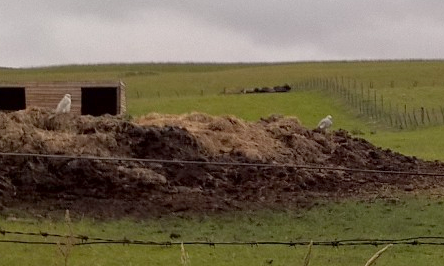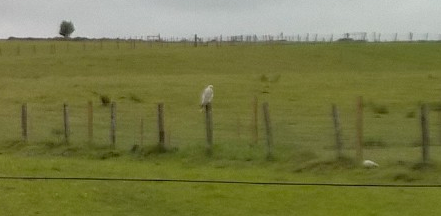
I got back from Iceland late last night and I’ll be writing more about Iceland and its whaling today and over the next few days. But one species of bird for which I kept an eye open was, of course, the Gyr Falcon – I didn’t see any.
However, I have been sent the image above, from Moray, which contains three apparently Greenland Gyr Falcons and I’ve also received a helpful clarification from SNH licensing team.
Can you see the three falcons above? Two of them are on what looks like a dung heap…

… and the other is on the fence…

What a sight! And it certainly looks as though there are free-flying Gyr Falcons (or maybe hybrid falcons) in this part of Scotland – it seems they are being wild-hacked. Remember that SNH has already told this blog that ‘The practice of releasing larger numbers of birds with the intention of gathering them after a period of days or weeks, sometimes referred to as wild hacking, will require a licence if it involves non-native birds[35]. To obtain a licence, contact Scottish Natural Heritage.’ and also that ‘There have been no licences applied for, issued or refused for wild hacking since the WANE Act came in to force‘ (ie 2011).
So, are hybrid falcons and Gyr Falcons non-native birds?
Hi Mark,
As you may know, the law in Scotland is slightly different to that in England and Wales. In terms of a species being ‘native’ or not the law is about releasing species outwith their native range.
Gyr falcons are considered to be outwith their native range in Scotland. Although they do turn up occasionally as vagrants, they are not on the Scottish list as a breeding species. This means that release of a gyr falcon in Scotland would be an offence.
A naturally occurring (e.g. vagrant) gyr falcon would be classified as a ‘wild bird’ under the terms of the Wildlife and Countryside Act because they are found within member states of the EU. This would not however apply to captive-bred birds.
Gyr hybrids would not be protected as a wild bird and it would be an offence to release or allow one to escape from captivity.
That seems quite clear. If you live in a part of Scotland where there are lots of Gyr-looking Falcons at loose in the countryside, and if this concerns you, then you might want to report this to SNH and ask them what measures they are going to take. You could also inform your local authority and the police.
[registration_form]
Outwith their normal range. Red-legged Partridges and Pheasants.
Curiouser and curiouser.
Inside their native range: wild boar, beavers, wolves, lynx, elk and bears?
Have specific exemptions under the relevant regulations. Maybe they shouldn’t, but they do
Reintroduction is defined as restoring a species to parts of its natural range from which it has been lost. It is just one type of ‘conservation translocation’.
SNH
https://www.nature.scot/professional-advice/safeguarding-protected-areas-and-species/reintroducing-native-species
There’s a bit of a fudge between definitions of ‘native range’ and ‘natural range’ which has caused confusion with regard to great crested newt translocations, but the regs are there. Scottish Gov had the powers to decide how beavers were classified and eventually decided to ‘nativise’ them last year. Lynx would be an introduced non native within its natural range if released.
https://www.nature.scot/professional-advice/safeguarding-protected-areas-and-species/protected-species/protected-species-z-guide/protected-species-beavers
https://www.nature.scot/professional-advice/safeguarding-protected-areas-and-species/reintroducing-native-species/scottish-code-conservation-translocations
Pheasant and partridge have exemptions that is
Pheasant and Red legged Partridges have exemptions-doesn’t surprise me in the slightest. Dismays me but then these two non-native species are the living targets of those who shoot for pleasure, what my very good friends Bill Hesketh and Bill Murphy in Bowland call quite rightly “pleasure killers.” As a by product some of these birds, most containing toxic lead rather than safer alternatives, end up in the human food chain. Under some circumstances one can justify hunting ( obtaining food pest controlling) but the pleasure of killing to my mind cannot be one of them.
As to free flying Gyr Falcons being wild hacked may be, just may be if controlled by licence is OK. I’ve personally never had a problem with falconry but free flying hybrids should be a definite NO, indeed the production of hybrids to be flown free should be banned for me.
I agree with Paul about pheasant shooting. This is not a reintroduction of Gyr into Scotland. These birds ( not sure of all the types ) they could be hybrids, peregrine, gyr no idea, some are white some grey and some quite dark but no organisation seems to be overseeing it. They wild fly in large numbers to strengthen their wings for a few weeks. They are then sent off to the middle east. Some are bred here and others come in from abroad and flown unattended but have tracers on them. The breeding and rearing of these birds has grown in Scotland over the last few years causing considerable upset to local communities. Buildings ( industrial units) to breed these birds are particularly ugly not to mention the noise levels of screeching birds especially while they are being fed. The whole thing is totally out of character with the rural farming countryside and it looks to be an unknown growing business. So we have to look at the whole picture to make sure this is what Scotland wants for its countryside. The Onus should be on the people who own or run these businesses to go through the relevant process and not leave it to the local community to question it.
Hacking falcons is nothing new. People have been doing it for many years and there hasn’t been any negative impacts on wild peregrine falcon populations, or wildlife in general that I know about. If done in a controlled way there should be no issue. Using radio and GPS transmitters means that the falcons can be tracked, and if lost then recovered quickly. Even if a falcon was lost for a longer period, it’s highly unlikely it would survive. This is a captive bred falcon that has never hunted before. Juvenile mortality in wild falcons is approx 60-70% in the first year, so a captive bred falcon that is not recovered is unlikely to survive beyond a few weeks. And anyway, if these falcons are so valuable (but not at the crazy prices quoted in some places) I’m sure people would do everything they can to make sure hacked falcons are recovered.
Paul – it is clear that it needs to be licensed – that’s the law. It appears that no licenses have been issued since 2011. So the possibility is that current wild hacking is unlicensed and illegal. Worth looking at, I’d have thought.
Hi Mark, as I understand wild hacking native species such as peregrine falcons doesn’t require a license, but for non-natives a licensed may be required. I would have thought that provided actions are taken to prevent loss (eg using GPS transmitters) and the falcons are closely monitored, then an offence may not be committed. Licensing may be a solution, but I think that would be for SNH to decide.
Paul – it is clear that wild hacking of Gyrs and hybrids does seem to require a licence – that’s what the quote in this post from SNH says. Licensing is the only way that this can be legal (as I understand it, but I’m not a lawyer, are you? I’m guessing not).
Hi Paul, can I ask where about in Scotland wild hacking in large numbers, unattended, albeit with GPS monitors, has been taking place? I haven’t found anywhere else, this seems to be a unique case. You said it has been going on for years which means there must be a process in place. If they need a licence and its that simple then why would they not apply for one and if it’s illegal why are they doing it? Given it seems to be a very organised operation this is confusing to me. Having a GPS only helps with their location and does nothing for what they are up to while out flying Many of our native birds ie. Lapwing, Curlew and Oyster catcher leave this location as soon as these birds start flying in their 40’s +. This at a time of nesting, I myself have witnessed that. The fact there has been no licence applied for after 2 summers of doing this is very strange.
A dead gyrfalcon was found in our garden, seemingly electrocuted on overhead wires as it spread its wings to take off from an electricity pole. It was up us to seek out the owner to report the apparently ‘unmissed’ bird. Similar birds are regular sightings on our property, sitting on our fences and flying low over our paddock; a large white falcon has even been close to landing on one of us. As far as we are aware, their presence on our property has gone unnoticed by the local breeders and the birds are never accompanied by a handler. Neighbours often report similar activity including frequent attacks on indigenous birds. If a license is required for wild hacking but none has ever been issued, it follows logically that the activities just described must be illegal.
But what can we do about it? What steps should be taken to put a stop to this? Reporting this type of activity doesn’t seem to prompt any action on the part of the SNH or anyone else, for that matter. It’s tragic that no official body seems interested enough to act. Priorities seem quite messed up – the recent ‘People’s Manifesto for Wildlife’ contains all the proof needed to suggest that enough’s enough! The days of window dressing and toothless government agencies must end!
The usual incompetent nonsense from SNH, Gyr Falcons migrate through Scotland every year and have been seen more regularly on the islands when there has been volcanic clouds persisting over Iceland so are a native species and don’t require licensing to wild hack.
I know the breeder of those falcons who works for a highly respected member of the Dubai Ruling family, someone who does a lot of work for global conservation. They will be pure Gyr Falcon.